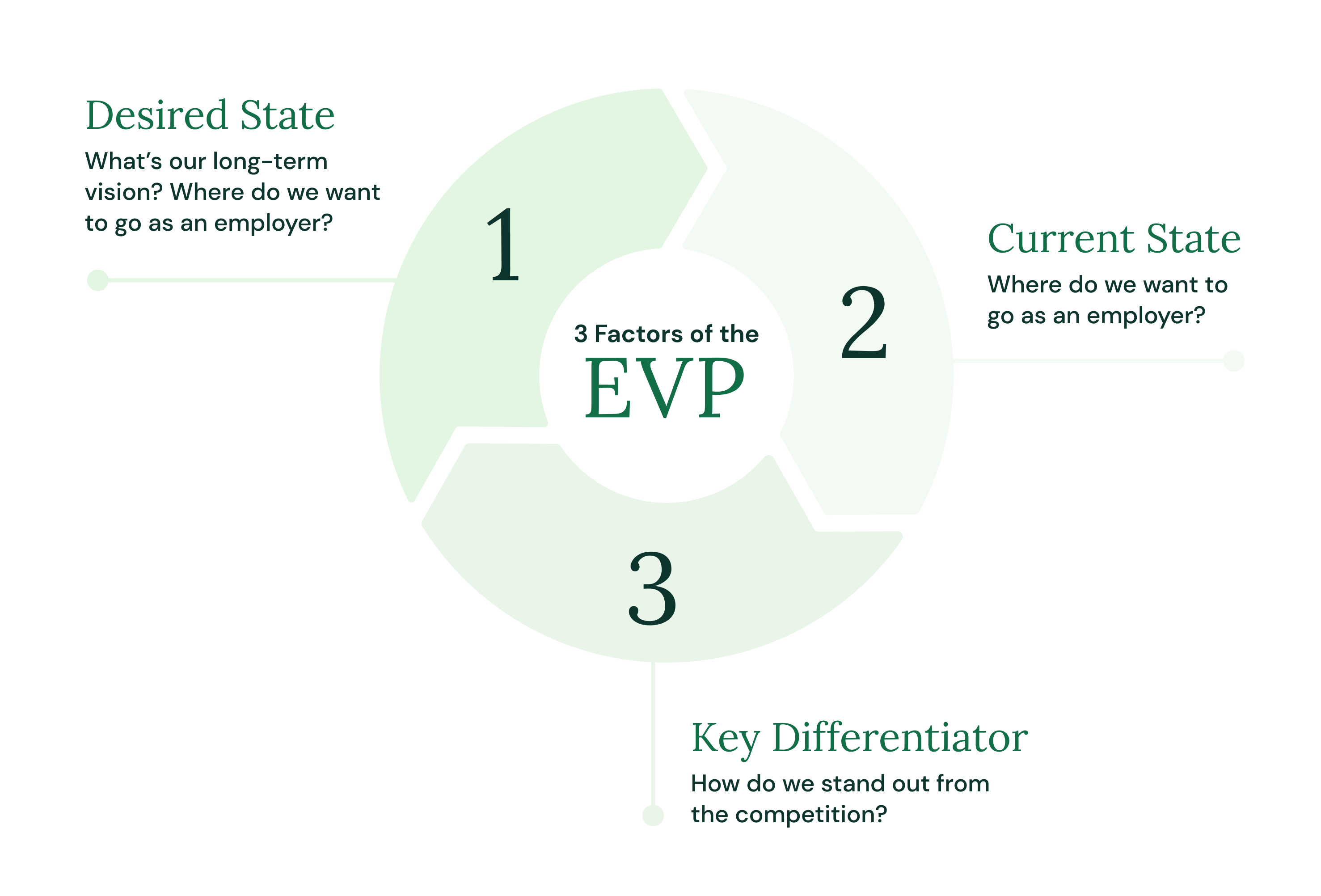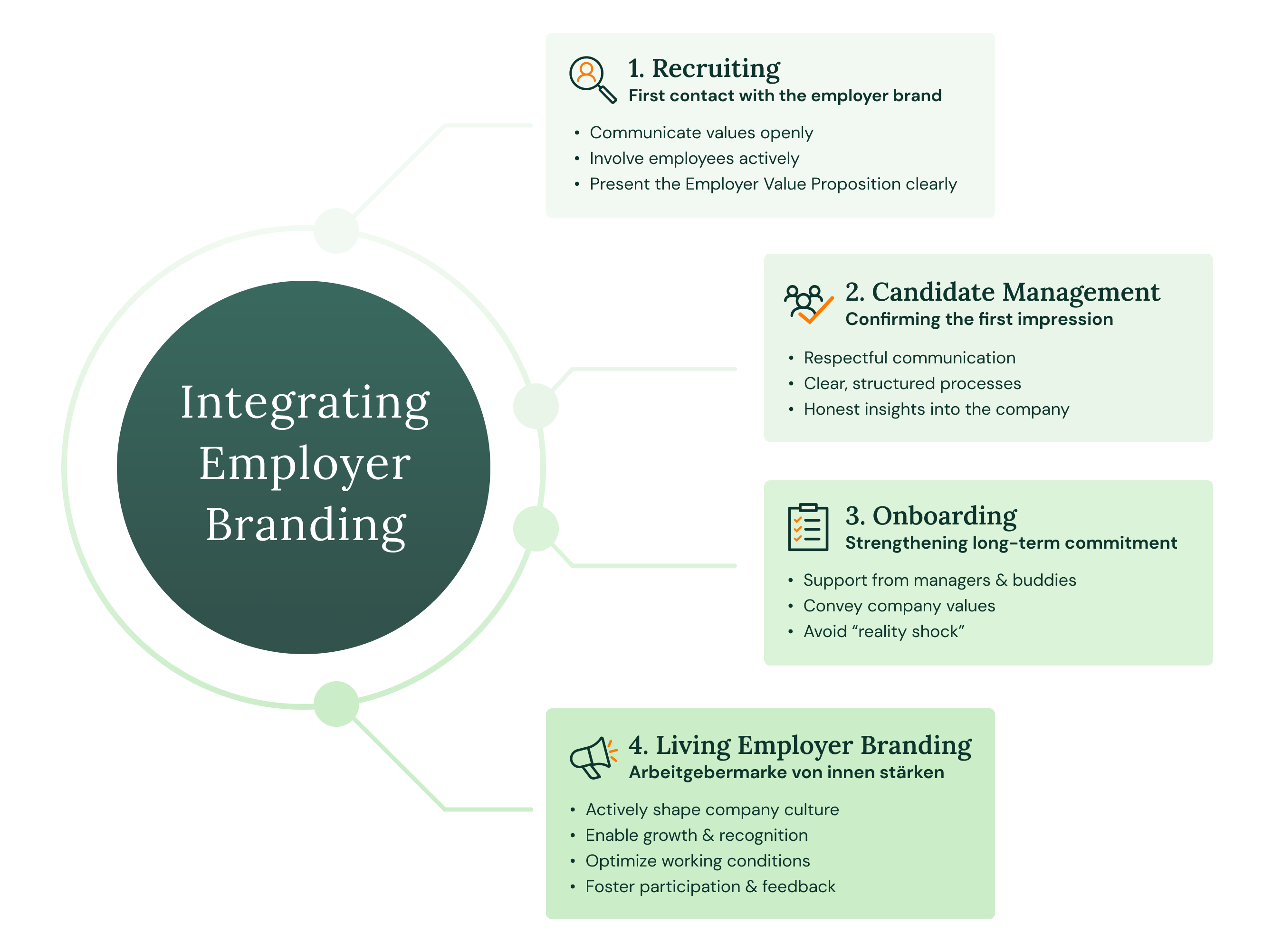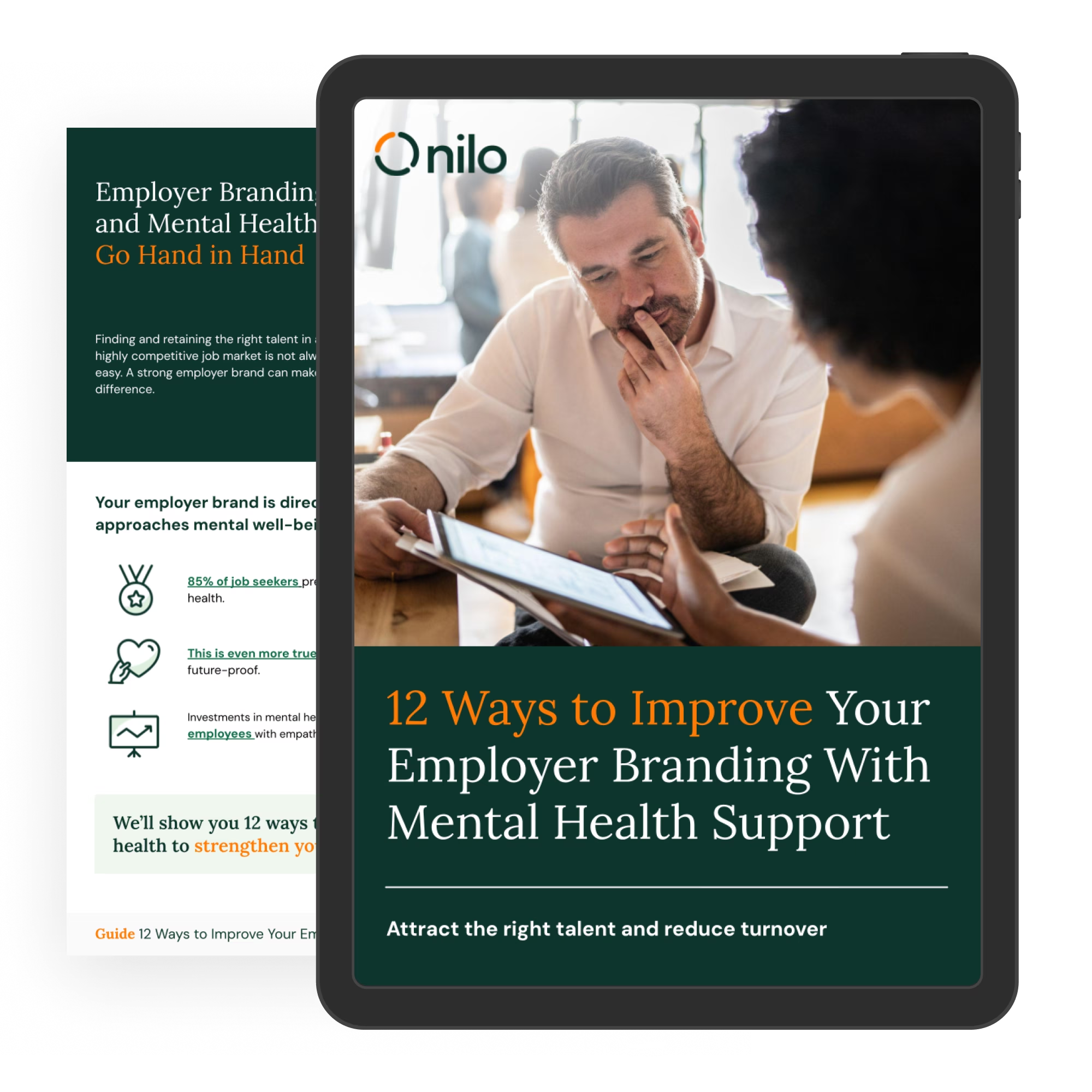Employer branding shapes how a company is perceived as a workplace – by potential candidates and current employees alike. A strong employer brand helps a company stand out from the competition, builds trust, and attracts the right talent. At the same time, it strengthens employee retention, deepens emotional connection, and boosts your reputation as an employer.
And it works: Studies by the University of Bamberg and the Fraunhofer Institute show that employer branding measurably increases employer attractiveness, employee satisfaction, and application numbers. What’s more, candidates are especially drawn to companies that take mental health seriously – 85% say they prefer employers who actively support their well-being.
This cheatsheet gives you a clear step-by-step guide – from the basics to quick wins – to help you turn your employer branding into real impact. Each tip and action step is ready for you to put into practice.
Step 1: Define your company values
Your company values are the personality of your organization. They reflect the beliefs and principles that shape your culture, guide decisions, and influence behavior — and they’re the foundation of any strong employer brand.
Already defined your values? Great! Then now’s the time to check whether they’re truly being lived and communicated across your company. If not, this is the perfect place to start.
How to develop company values — together with your team
Values shouldn’t be written behind closed doors. They should be developed through honest conversations with the people who shape your company. Try formats like:
- Workshops with team members from across the business
- Anonymous surveys to collect candid feedback
- 1:1 conversations to understand personal perspectives
Use this input — along with your strategic business goals — to define values that are authentic and clear. Strong company values are positively framed, easy to understand, and deeply embedded in your processes, communication, and everyday behavior.
Why company values matter for employer branding
Clearly defined values create direction:
- Internally, for employees — for example, when making decisions or shaping how teams work together
- Externally, for candidates — as they ask themselves: “Is this the kind of company I want to work for?”
Your values help you attract people who share similar beliefs — laying the groundwork for authentic employer branding.
From words to workplace culture
Values only make an impact when they’re backed by real actions and behaviors. Take “transparency” as an example — it becomes meaningful when it’s reflected in open communication and regular feedback.
Leaders play a key role here: they set the tone and should model the values day to day.
Step 2: Build a strong foundation for your employer branding
How do you define goals and target audiences for employer branding?
From recruiting and employee retention to internal culture work — employer branding touches a lot of areas. That’s why it’s essential to set clear goals and prioritize them.
Start by asking yourself: What do we want employer branding to achieve?
- More applications?
- A better match between candidates and roles?
- Higher employee satisfaction?
- Greater visibility as an employer?
Just as important is defining your target audience. Who exactly are you trying to reach? Young talent or experienced professionals? Tech experts or healthcare staff? People with specific values or interests?
Only when you truly understand your audience can you craft a message that resonates — with the right tone, the right channels, and an authentic presence.
Once your goals and audience are clear, employer branding becomes much more actionable. You’ll know who you’re speaking to, what message you want to send, and where to focus your efforts.
How do you define an Employer Value Proposition (EVP)?
The Employer Value Proposition — or EVP for short — is your company’s core promise to current and future employees. It answers two key questions:
Why should talent join your company — and why should they stay?
What goes into an EVP?
Your EVP includes everything that makes your company attractive as an employer: compensation, work environment, career development, company culture, work-life balance, and social impact.
It’s a promise that reflects your identity, your culture, and your strategic direction.
While the EVP is the substance of what you offer, employer branding is about bringing that promise to life — communicating it to the outside world in a way that resonates.
How to develop a credible Employer Value Proposition
For your EVP to truly resonate, it has to be authentic — a real reflection of what your company stands for. These three steps will help you build a strong foundation:

-
Analyse your current state
What values, benefits, and working conditions shape your culture today? Look at both the hard facts (like salary or working hours) and the softer aspects (like leadership style or team dynamics). -
Understand your ideal state — and what your target group needs
What really matters to the people you want to attract? What do they expect — and what do your current employees value most? The better you understand these needs, the more relevant and compelling your EVP will be. -
Identify your unique strengths
What sets you apart from the competition? It might be flexible work models, purpose-driven projects, or a standout company culture. Whatever it is — make sure to communicate it clearly.
Real-world EVP examples
Patagonia’s Employer Value Proposition centers on environmental and social responsibility. Employees are encouraged to actively contribute to sustainability projects — allowing them to align their day-to-day work with their personal values. The result? A strong sense of emotional connection and purpose.
Eventbrite sums up its EVP with the tagline: “You’re invited to do your best work.” The company offers flexible work arrangements — remote, in-office, or hybrid — and supports employees through every stage of life. Their benefits package is extensive, covering everything from financial perks to insurance, health, and well-being — no matter where employees are based.
How do you develop a well-being strategy?
How a company treats its people has a direct impact on its employer brand. One area that’s increasingly in the spotlight: mental health. More and more candidates are actively looking for employers who support mental well-being. Companies that offer meaningful initiatives in this space strengthen their Employer Value Proposition — and become more attractive to top talent.
Key elements of a holistic well-being strategy
- Physical well-being: Ergonomic workspaces, health initiatives, preventive care, access to sports or gym memberships.
- Emotional well-being: Mental health support, stress management workshops, resilience training.
- Social well-being: Team events, mentoring programs, and initiatives around diversity, equity & inclusion.
- Financial well-being: Financial coaching, support during personal financial crises, retirement planning.
- Professional well-being: Learning opportunities, career development, meaningful projects, and flexible work models.
- Purpose: Projects and tasks that give employees a sense of fulfillment and positive social impact.
Why mental health matters more than ever
A 2024 survey by Statista found that 91% of Baby Boomers (aged 59 and up) and 75% of Gen Z (18–26) in Germany consider mental health offerings important. Among Millennials and Gen Z, 71% said clear mental health policies are a key factor when choosing an employer.
Practical steps to support mental well-being in your team
A strong mental health strategy should address multiple dimensions:
- Confidential counseling with trained psychologists and mental health professionals who offer quick, professional support.
- Workshops and training to raise awareness, reduce stigma, and build everyday resilience.
- Flexible work models that support work-life balance and help employees align personal needs with professional demands.
- Wellness initiatives like mindfulness sessions, meditation, or yoga classes that actively promote relaxation and recovery.
- Leadership training to help managers recognize early signs of stress, support their teams effectively, and lead by example when it comes to mental health.
How do you define meaningful employee benefits?
In addition to values, your EVP, and well-being initiatives, employee benefits play a key role in employer branding. They make your offer as an employer tangible — and help talent make a conscious decision to join you.
What counts as a benefit?
Benefits are any additional perks that go beyond salary and actively improve your employees’ lives. These might include:
- Financial benefits: Bonus schemes, company pension plans, employee stock options
- Flexible schedules: Flextime, trust-based working hours, additional vacation days
- Work-life balance perks: Remote work, sabbaticals, or workation opportunities
- Health & wellbeing: Gym subsidies, healthy office snacks, mental health support
- Learning & development: Training, mentoring, or budgets for external courses
- Family support: Childcare assistance, parental leave policies, support for caregiving responsibilities
What really matters when it comes to benefits?
Benefits shouldn’t just sound good on paper — they need to actually reflect the reality of your employees’ lives. That means:
- Relevance over quantity
- Quality over variety
- Don’t forget communication — even the best benefits fall flat if no one knows about them.
Pro tip: Ask your current employees which benefits they actually use and value. Then build your offer around what really matters to them. It shows appreciation — and strengthens your internal employer brand at the same time.
Step 3: Embed and communicate employer branding in your company processes
Employer branding only makes an impact when it’s embedded into day-to-day work and core business processes. From the very first job posting to ongoing employee development, your employer brand should be visible and tangible.

Here’s how you can anchor employer branding across key HR touchpoints:
1. Recruiting: The first contact with your employer brand
The recruitment process is often a candidate’s very first interaction with your employer brand — so make it count. This helps you attract better-matched applicants, improve hiring quality, and increase brand visibility.
-
Communicate your values and culture
Your careers page, job ads, and profiles on platforms like Glassdoor or kununu are your cultural shop window. Use them to make your values tangible — for example, by sharing clear statements about your way of working, leadership style, or team culture. What do you genuinely live? What sets you apart? What can new hires expect? -
Use engaging formats
Choose formats that spark emotion and create connection:- Videos featuring real employees sharing their perspectives
- Behind-the-scenes content on social media (“Life @…”)
- Podcasts or short interview reels with leaders or apprentices
-
Involve your employees
Your employees are the most credible ambassadors of your employer brand. Involve them actively — in testimonials, social media content, or as hosts at candidate events. -
Align recruiting services with your employer brand
If you work with external recruiters or agencies, make sure they understand your EVP, tone of voice, and target audience. Otherwise, your brand message risks getting lost. -
Put your Employer Value Proposition front and center
Your EVP should be easy to find — ideally on the homepage of your careers site — but it shouldn’t stop there. It should be woven into every job posting, addressed in interviews, and visible in recruitment emails or campaigns. The clearer you communicate what makes your company unique, the more likely you are to attract the right talent.
2. Candidate management: Back up the first impression
A great candidate experience brings your employer brand to life — long before a new hire’s first day. This stage often determines whether talent stays excited or decides to walk away.
-
Respectful communication
Candidates don’t want to wait weeks for a response or get generic email templates. Fast, transparent, and personal communication shows respect and makes people feel welcome from the start. -
Clear, structured processes
Make it easy for candidates to understand what’s happening: Who will be in touch? What are the next steps? When can they expect feedback? A transparent process reduces uncertainty — and saves your internal team time and effort. -
Offer honest insights into your team and culture
People want to know what they’re signing up for. Give candidates real insight into how your teams work, what your values look like in action, and how your company is structured. This helps both sides figure out whether it’s the right fit — reducing future mismatches and improving hiring quality.
3. Onboarding: Strengthen long-term engagement
Onboarding is the moment of truth: it’s where new hires find out whether the promises made during recruiting actually hold up. This phase is crucial in deciding whether people truly settle in — or mentally check out before they’ve even begun.
-
Structured onboarding process
Plan a clear, multi-step onboarding journey — one that can stretch across several weeks if needed. A well-organized structure provides stability and helps new hires become productive and feel part of the team faster. -
Support from managers and buddies
Assign a go-to person who can help new employees find their feet. Regular check-ins, personal conversations, and genuine human connection (not just information dumps) show that people are seen and valued. -
Focus on values — not just tools
Use formats like welcome sessions, culture handbooks, internal storytelling, or small team rituals to make your company culture come alive. New hires should get a feel for how things work around here — not just how to use Jira. -
Avoid the “reality shock”
If the day-to-day reality doesn’t match what was promised during the hiring process, frustration sets in fast. Be honest from day one — about challenges, change, and also about the opportunities to grow and contribute.
4. Strengthen employer branding from within
Employer branding doesn’t end once the contract is signed. In fact, that’s where it really begins. Day-to-day experience within the company determines whether your employer promise holds up.
A strong, lived company culture and employees who feel genuinely connected to their workplace are the foundation of lasting employer branding. And it’s your satisfied employees who make the best brand ambassadors: they promote your employer brand out in the world — authentically, credibly, and without needing a marketing budget.
So how can you tap into that potential to build long-term engagement and true identification with your company? That’s what the next step is all about.
Step 4: Strengthen employee retention through internal employer branding
Employer branding isn’t just about attracting new talent, it’s just as critical for retaining the people you already have. Your employer brand only becomes truly credible when it’s reflected in everyday work life.
To retain employees long term, companies need to offer more than a good salary. What matters most is a lived culture, meaningful involvement, growth opportunities, and a healthy work environment.
These are the most effective ways to strengthen your internal employer brand:
1. Actively shape your company culture
-
Live your values and vision
Company values and goals shouldn’t exist just on slides — they need to show up in day-to-day decisions, team dynamics, and especially in leadership behavior. -
Leaders as role models
Leaders set the tone for your culture. They should embody your values, offer clear guidance, and take a stand when those values are at risk.
2. Strengthen internal communication
-
Transparent communication
Open, regular updates about wins, changes, and challenges build trust and foster a sense of belonging, especially during difficult times. -
Communication shouldn’t be a one-way-street
Employer branding thrives on participation. Use formats like feedback sessions, internal surveys, or regular Q&As to give employees a voice — and show that it’s heard.
3. Encourage participation
Employees who actively help shape their work environment and internal processes tend to feel more connected to the company. Create opportunities for meaningful involvement, for example through:
- Internal project groups
- Culture initiatives
- Innovation programs
4. Enable growth and recognition
-
Create opportunities for development
Offer clear career paths, training programs, and personalized development options. When people see they can grow within the company, they’re more likely to stay — and to stay motivated. -
Show appreciation
Recognition is a key driver of retention. That might be financial (bonuses, perks), but it can also be non-monetary — like praise, visibility, or internal awards.
5. Improve working conditions
-
Offer flexibility
Flexible working models are now a key factor in employee retention. Flextime, remote work, hybrid setups, and personalized solutions for balancing work and family life allow employees to structure their days with more autonomy. This boosts satisfaction and reduces turnover. -
Support health and wellbeing
Working conditions have a direct impact on motivation and performance. Ergonomic workspaces, quiet zones, healthy snacks, and physical activity programs can significantly improve daily work life. Even more impactful are initiatives that support mental health — like mindfulness training, stress management workshops, or access to psychological counseling services such as nilo. A culture of appreciation and regular team events also help create an environment where people want to stay.
6. Gather feedback and keep evolving
-
Ask for feedback and act on it
Use employee surveys, pulse checks, or regular feedback sessions to understand what’s working and where there’s room for improvement. -
Keep refining your approach
Internal employer branding isn’t a one-way street. Continuously adapt your initiatives to your team’s evolving needs. That’s the only way to keep your employer brand relevant, authentic, and alive.
Step 5: Measure your success
Running employer branding without measuring its impact is like hiring without holding an interview: You might have a gut feeling, but no solid foundation to build on.
To actively steer and improve your employer branding strategy, you need clear KPIs that capture both quantitative and qualitative aspects.
One thing to keep in mind: employer branding influences many so-called “soft” factors — like satisfaction, engagement, and perception. But even these can be tracked, analyzed, and used to make better decisions.
The overview below highlights key metrics and proven methods to help you measure and showcase the impact of your employer branding efforts.
Measure the impact of your employer branding efforts
| KPI | What’s being measured | How it’s measured |
|---|---|---|
| Number of applicants | Visibility and attractiveness of your employer brand | Applicant tracking systems, before/after campaign comparisons |
| Candidate Experience Score | How candidates perceive your employer brand during the hiring process | Post-application or interview surveys (e.g. via email or NPS tools) |
| Time-to-hire | Speed of the recruitment process | Time from job posting to contract signing |
| Application quality | Fit and suitability of applicants | Interview-to-offer ratio, hiring manager feedback |
| Employee satisfaction | Internal sentiment around the employer brand | Employee surveys, pulse checks, eNPS |
| Employee retention / turnover | Long-term loyalty and team stability | Turnover rate, average tenure, exit interviews |
| Engagement on social media and review platforms | External perception and response to employer branding efforts | Likes, shares, comments, reviews on platforms like kununu and Glassdoor |
| Employee advocacy / brand ambassadors | How actively and positively employees promote the brand externally | Social media monitoring, referral numbers, internal ambassador programs |
3 Quick Wins: Small steps, big impact
Employer branding doesn’t have to be a massive undertaking. Sometimes, it’s the small, concrete actions that make the biggest difference. These quick wins are easy to implement and send a strong signal — both internally and externally.
1. Careers page & employer presence
-
Refresh your careers page
Update text and images to reflect your culture and benefits authentically. Add real employee quotes, update your team photo, and make the application process simple and user-friendly. -
Feature employee testimonials
Collect short quotes or mini-stories from your team and share them on your website, LinkedIn, or Instagram. -
Strengthen your social media presence
Give regular behind-the-scenes glimpses into daily life — spontaneous team moments, employee takeovers, or short video clips from the office. -
Share employee spotlights on LinkedIn
Introduce team members through personal stories and insights into their role. Keep it real, relatable, and human. -
Encourage employer reviews
Invite happy employees to leave honest reviews on platforms like kununu or Glassdoor. It’s one of the most powerful ways to shape external perception.
2. Onboarding & internal communication
-
Welcome kits for new employees
A small, thoughtful onboarding gift — like a welcome letter, branded mug, or company swag — helps create an emotional connection from day one. -
Share internal success stories
Use newsletters or internal channels to celebrate project milestones, completed training programs, or work anniversaries. -
Start a quick feedback habit
Introduce lightweight formats like “praise of the week,” 15-minute feedback check-ins, or shout-outs via Slack. Small gestures, big impact.
3. Boost team spirit and connection
-
Virtual coffee breaks or after-work events
Especially important in remote setups — create casual, agenda-free spaces where people can just connect. -
Small surprises that go a long way
Ice cream on hot days, handwritten birthday cards, or an unexpected bouquet — small touches that stick with people. -
Health days and mental wellbeing webinars
Offer regular wellbeing-focused sessions to show you’re not just talking about mental health, but actively supporting it — in ways that fit everyday life.
Conclusion: Putting your employer branding into action
Employer branding isn’t a one-time project. It’s a continuous process that starts from within and shapes how you’re perceived externally. With clear values, a strong EVP, and a workplace culture people can genuinely experience, you’ll not only attract the right talent but also retain your existing team over the long term.
Begin with small, visible steps. Whether it’s quick wins or targeted actions along your employee journey, stay consistent in measuring your impact. That’s how your employer brand gradually becomes a true competitive advantage.








